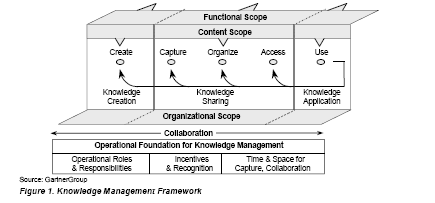
Training as a Communication Strategy
The Knowledge-Based Organization: Managing Its Human Resources
Learning Objectives
Knowledge is the, principal factor that makes personal, organizational, and societal intelligent behavior possible.
Knowledge management is the process used by organizations to identify and capture information that is valuable to others.
----
The seven principles
of Knowledge Management
KM: Going Beyond Training and
Development
Knowledge Management goes beyond training and development because we recognize that neither training nor development is enough and each has its limitations. Whereas development is based more on the desires of the individual having higher priority than the needs of the organization, training is based more on the needs of the organization, the desires of the individual having lower priority.
Training is often less effective in a world of uncertainty, where technology and competition make the environment more turbulent and the need for knowledge acquisition imperative. Employee development, on the other hand, may help individuals accept the uncertainty but be less able to guide them to the types of knowledge that will be important in the future functioning of the organization. This can lead to frustration and disappointment by the employees who are sent off on courses but are not allowed to implement or practice what they have learned when they return to their organizations. The result will be a large and pointless waste of time and resources for the organization.
To go beyond training and development is to see the human resources function as more responsive to the conditions of the coming (and some believe it’s already here) knowledge economy. That moves management thinking to a new way of thinking about organizations and what information is valuable. Organizations, which take knowledge management seriously, will share many of the characteristics of the "learning organization" (Sense, 1990). It emphasizes openness (knowledge needs to be seen as available to and emanating from all employees), the development of new knowledge and new kinds of knowledge, and the importance of being aware of knowledge as a product and process.

Knowledge Workers and Learning Organizations
Project/programme purpose success depends on the ability to learn, and the best knowledge workers excel at solving problems created by both external forces and their own past behavior. This dual skill has been called “double loop” learning.
What is the difference between double loop learning and single loop learning?
What most organizations engage in is single-loop learning, where errors are corrected using past routines and present policies. In double-loop learning, errors are corrected by modifying the organization’s objectives, policies and standard routines.
Consider the following example: In single loop learning, a thermostat set at 68 degrees activates the heater whenever the temperature falls below 68. In double loop learning, a person ponders whether 68 degrees is the optimum temperature. Knowledge workers who exhibit double loop learning prevent their organizations from getting stuck in ruts.
Organizational learning demands individual learning, creativity and the ability to think critically. Knowledge workers can be found in all industries and at many levels of an organization, but Learning Organizations essentially require that all employees act as knowledge workers. These organizations stress individual capacities for adaptation and change, and they value continuous learning about both technical skills and the external environment. Employees take risks so they learn, seek enduring solutions instead of quick fixes, and capitalize on their collective knowledge.
See Knowledge Workers and Learning Organizations; Computer based Knowledge Management and People
Peter Senge identified five “learning disciplines” that lie at the core of Learning Organizations: personal mastery, mental models, shared vision, systems thinking, and team learning.
1. Personal Mastery refers to an organizational environment that encourages all its members to develop special proficiencies through life-long learning. Professional development is viewed as crucial to organizational success.
2. Mental Models indicates a practice for reflecting upon, scrutinizing and improving mental models – an individual’s way of looking at the world and situations, which shape decisions. Flawed mental models lead to mistakes, but knowledge workers who identify flaws in their mental models can correct them to reach superior decisions.
3. Shared Vision means building a sense of commitment by developing shared images of the future that the organization seeks and the guiding principles by which it hopes to get there.
4. Systems Thinking is a organization-wide way of understanding forces that shape the behavior of an organization’s systems. Employees exhibit an awareness of the interconnectedness and interdependency of team members, of teams in organizations and organizations in the larger environment.
5. Team Learning refers to improving team processes so groups of employees can reliably develop abilities greater than the sum of the talents of individual members.
See Knowledge Workers and Learning Organizations; Computer based Knowledge Management and People
Web Based Training (WBT) Course Evaluation Form
Web Site Creation Strategy
-----------
See aslo :
Computer based Knowledge Management and People